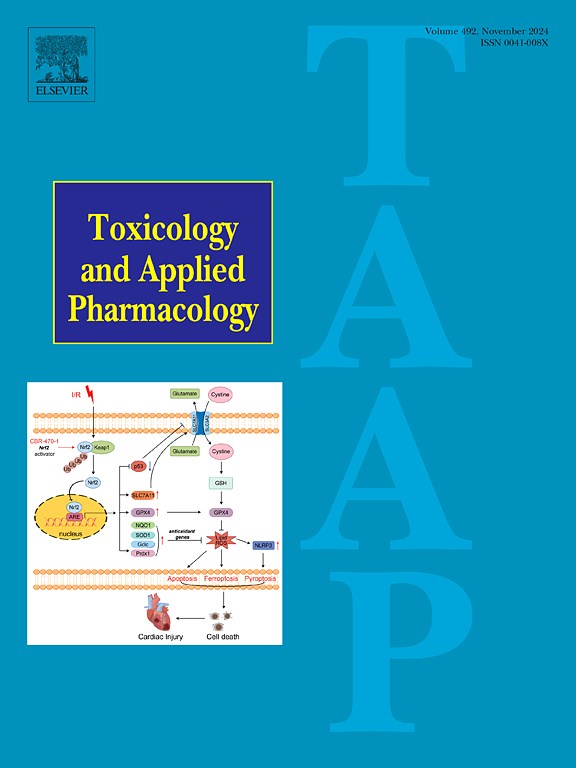Association of arsenic exposure with PDGF-BB in vitro and in a South Texas population exposed through drinking water
IF 3.3
3区 医学
Q2 PHARMACOLOGY & PHARMACY
引用次数: 0
Abstract
Exposure to arsenic (As) from drinking water is a global public health concern, as As is a recognized carcinogen. Groundwater in South Texas, particularly in areas with Gulf Coast aquifers, contains high levels of As. Private wells are neither regulated nor regularly monitored, leaving residents vulnerable to arsenic exposure. This study aimed to investigate potential biomarkers of health effects for long-term, low-level As exposure among private well users in South Texas and to cross-validate findings using an in vitro model. Among 74 private well users, the association between urinary As levels and urinary LDH and 16 cytokine levels was assessed. After adjusting for covariates, linear regression analysis showed weak but significant associations between urinary total inorganic As levels and LDH (β = 0.37, p < 0.01, R2 = 0.23) and PDGF-BB (β = 0.22, p = 0.02, R2 = 0.17). However, no significant associations were found with other cytokines. To compare findings from the population study, SV-HUC-1 uroepithelial cells were exposed to 0.1 or 0.5 μM NaAsO₂ subchronically for 5 weeks, corresponding to total arsenic levels of 7.5 and 37.5 μg/L in drinking water. As exposure was not cytotoxic at either dose, as indicated by lactate dehydrogenase (LDH) activity. However, platelet-derived growth factor (PDGF)-BB protein levels showed a statistically significant increase at a lower concentration of 0.1 μM. These findings suggest that PDGF-BB may serve as a potential biomarker for low-level As exposure, but further studies are required for confirmation.
砷暴露与体外PDGF-BB的关系以及在南德克萨斯州通过饮用水暴露的人群中
砷是一种公认的致癌物,从饮用水中暴露于砷(As)是一个全球性的公共卫生问题。德克萨斯州南部的地下水,特别是墨西哥湾沿岸的地下含水层,含有高浓度的砷。私人水井既不受监管,也不受定期监测,居民很容易受到砷的侵害。本研究旨在调查南德克萨斯州私人井用户长期低水平砷暴露对健康影响的潜在生物标志物,并使用体外模型交叉验证研究结果。在74名私家井使用者中,评估了尿As水平与尿LDH和16种细胞因子水平之间的关系。调整协变量后,线性回归分析显示尿总无机砷水平与LDH之间存在微弱但显著的相关性(β = 0.37, p <;0.01, R2 = 0.23)和PDGF-BB(β= 0.22,p = 0.02, R2 = 0.17)。然而,与其他细胞因子没有明显的关联。为了比较人群研究的结果,SV-HUC-1尿路上皮细胞亚慢性暴露于0.1或0.5 μM NaAsO₂中5周,对应于饮用水中总砷水平为7.5和37.5 μg/L。正如乳酸脱氢酶(LDH)活性所表明的那样,两种剂量的暴露都没有细胞毒性。然而,血小板衍生生长因子(PDGF)-BB蛋白水平在较低的0.1 μM浓度下显示有统计学意义的升高。这些发现表明PDGF-BB可能作为低水平砷暴露的潜在生物标志物,但需要进一步的研究来证实。
本文章由计算机程序翻译,如有差异,请以英文原文为准。
求助全文
约1分钟内获得全文
求助全文
来源期刊
CiteScore
6.80
自引率
2.60%
发文量
309
审稿时长
32 days
期刊介绍:
Toxicology and Applied Pharmacology publishes original scientific research of relevance to animals or humans pertaining to the action of chemicals, drugs, or chemically-defined natural products.
Regular articles address mechanistic approaches to physiological, pharmacologic, biochemical, cellular, or molecular understanding of toxicologic/pathologic lesions and to methods used to describe these responses. Safety Science articles address outstanding state-of-the-art preclinical and human translational characterization of drug and chemical safety employing cutting-edge science. Highly significant Regulatory Safety Science articles will also be considered in this category. Papers concerned with alternatives to the use of experimental animals are encouraged.
Short articles report on high impact studies of broad interest to readers of TAAP that would benefit from rapid publication. These articles should contain no more than a combined total of four figures and tables. Authors should include in their cover letter the justification for consideration of their manuscript as a short article.

 求助内容:
求助内容: 应助结果提醒方式:
应助结果提醒方式:


